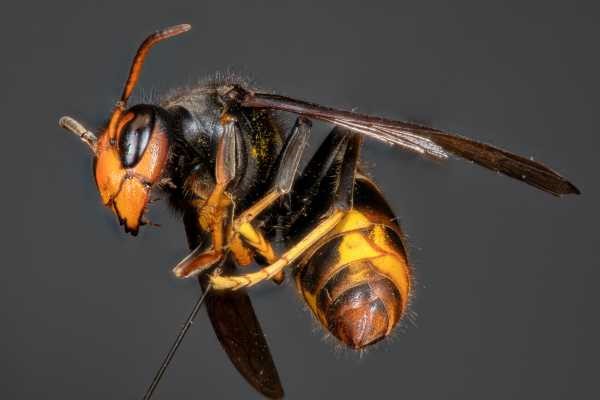The Bald-faced Hornet - Dolichovespula maculata
Despite the name, the Bald-faced hornet (or 'Baldfaced hornet) is actually a large 'yellowjacket' type wasp rather than a 'true hornet'1, since it belongs in the genus Dolichovespula1.
(True hornets belong to the genus Vespa, and include species such as the Asian giant hornet, Vespa mandarinia, and the European hornet - Vespa crabro).
Bald-faced hornets have distinctive black and white markings and are found throughout North America and Canada.
The Lifecycle Of The Bald-faced Hornet
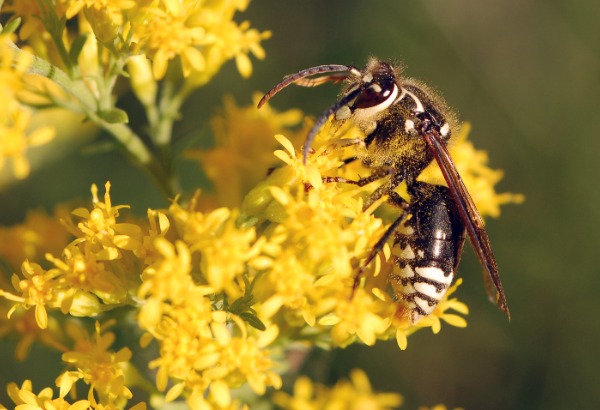 Bald-faced hornet foraging on Goldenrod (Solidago)
Bald-faced hornet foraging on Goldenrod (Solidago)Bald-faced hornets are eusocial insects, with new colonies founded by a single fertile queen.
Bald-faced hornet queens typically measure up to 20 mm, and her offspring range in size from 13 mm to 20mm2.
The queen emerges in the spring, having overwintered in a suitable crevice (perhaps in a tree or piece of wood) or a sheltered location (a log pile, or roof space, for example).
She begins to establish a nest by creating several nest cells in which she lays eggs, and from which she raises the first of her offspring that will emerge as female workers.
Once the workers are fully grown, they take over nest building duties, guarding and provision of food for the queen's offspring, whilst the queen now focuses on egg-laying.
Eventually, a colony will grow to between 100 to 400 workers2.
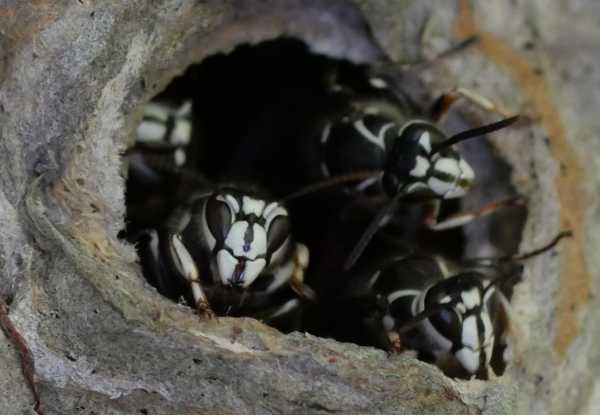 Bald-faced hornets at a nest entrance.
Bald-faced hornets at a nest entrance.Photo by Keith Edmondson
Males and new queens are usually reared in the autumn. Once they emerge from the nest they embark on mating flights to mate with individuals from other colonies3.
Research suggests that males are drawn to a sex attractant pheromone, which has been found to be present on the outer body surface of virgin Bald-faced hornet queens4.
After mating, the males die3, whereas the newly fertilized queens will find a place to overwinter, ready to re-emerge the following year to establish new colonies of their own.
What Do Bald-faced Hornets Eat?
Hornet larvae need protein in the form of other invertebrates and their larvae or pupae. They are also fed nectar and sugary secretions such as honeydew5.
Adults feed on larval secretions followed by nectar.
Bald-faced Hornet Nests And What's Inside A Nest?
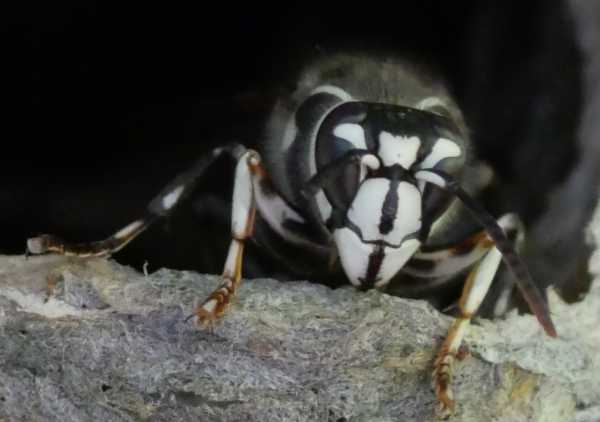 Bald-faced hornet apparently guarding a nest entrance.
Bald-faced hornet apparently guarding a nest entrance.Photo by Keith Edmondson
I am indebted to a Mr Keith Edmondson from the Washington DC metro area in Virginia, who sent me a number of fabulous photographs of Bald-faced hornets and their nests.
Nests are constructed in a variety of locations, and can sometimes be seen attached to buildings, such as deck overhangs.
However, they are usually found within the branches of shrubs or attached to a branch high up in a tree.
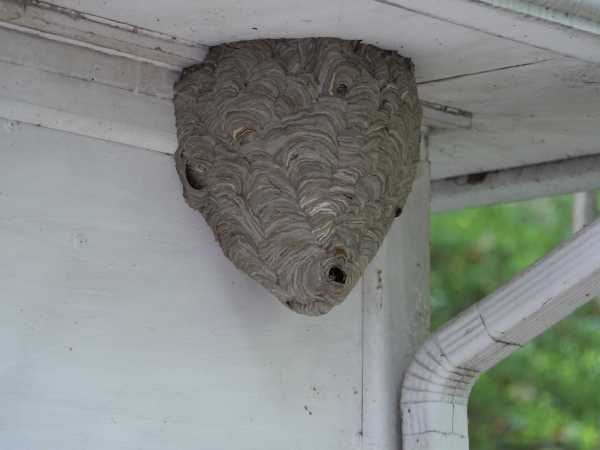 Bald-faced hornet nest, the entrance is the hole at the bottom.
Bald-faced hornet nest, the entrance is the hole at the bottom.Photo by Keith Edmondson
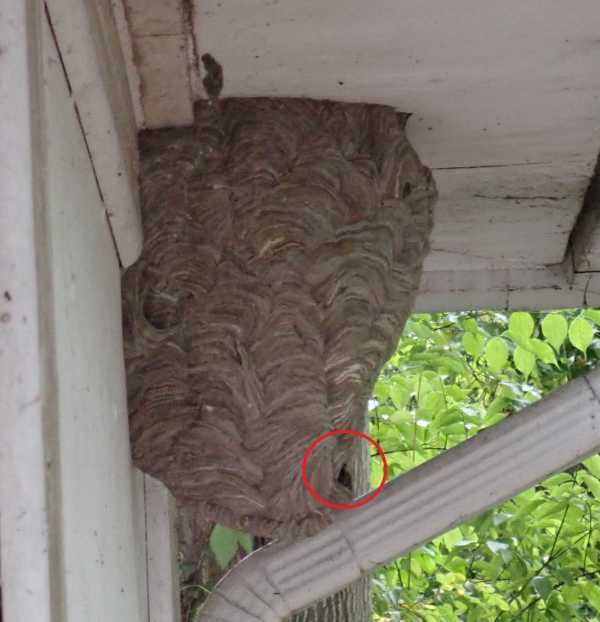 The same nest after further construction work by busy worker Bald-faced hornets! The entrance is highlighted with a red circle.
The same nest after further construction work by busy worker Bald-faced hornets! The entrance is highlighted with a red circle.Photo by Keith Edmondson
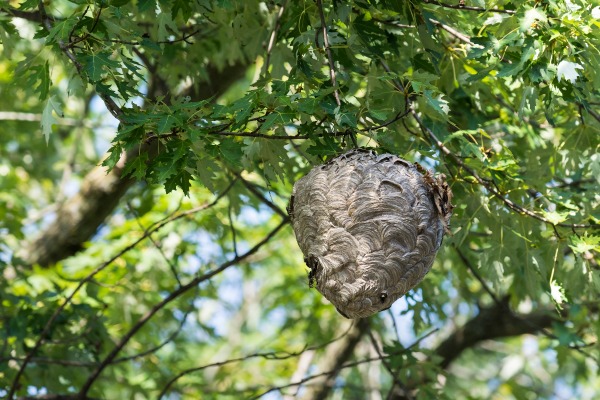 Bald-faced hornet nest high in a tree.
Bald-faced hornet nest high in a tree.Nests (as with other other social wasp nests) are created from tiny, fine slithers of wood gathered, chewed and layered together to form hexagonal nest cells within a greyish, vaguely upside-down-egg-shaped or conical paper ball (depending on how the nest is supported and where it hangs from).
Below is a further photograph by Keith Edmondson. It's a close-up shot revealing the papery fibrous composition of the nest.
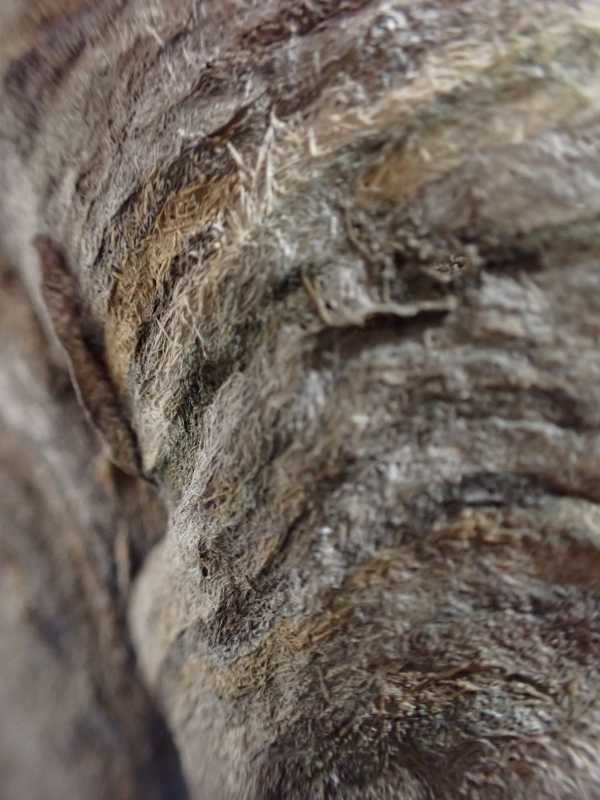 The outer papery fibrous texture of a Bald-faced hornet nest.
The outer papery fibrous texture of a Bald-faced hornet nest. Photo by Keith Edmondson
For further information, see my page about the structure of a social wasp nest.
How many queens in a Bald-faced hornet nest?
A colony is established by a single queen, and for a while, only one queen will be present in a nest.
However, later, as new queens are reared, there may be several queens in the nest until they leave to mate and find a suitable site for overwintering.
Nest Defence
As with other social and eusocial insects, nests contain a large number of protein-rich larvae and pupae which potentially makes an attractive feast for predators, including birds, mammals and other invertebrates.
To protect the nest, worker Bald-faced hornets guard the nest entrance.
Research suggests they may also use sting venom volatiles as an alarm pheromone that elicits targeted attacks to threats by multiple workers6.
Do I need to remove a Bald-faced hornet nest?
This probably depends on whether or not the nest is likely to cause concern (for example, due to an uncommon but dangerous allergy to stings that could cause anaphylactic shock - as can also happen with bee stings).
Nests located away from the house and up in a tree may not bother you if left alone.
Nests only last a season.
Are Bald-faced hornets good to have around?
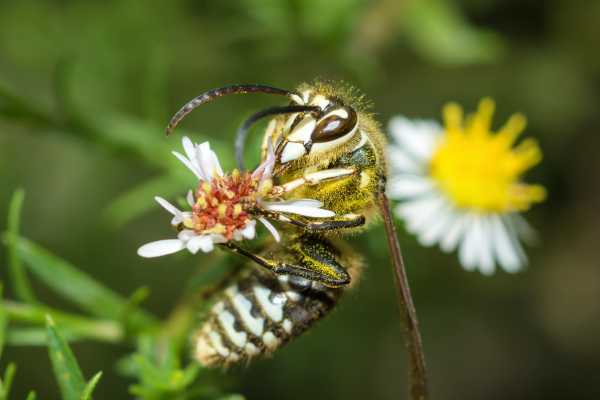 Bald-faced hornet showing hairs covered in a dusting of yellow flower pollen.
Bald-faced hornet showing hairs covered in a dusting of yellow flower pollen.On balance, Bald-faced hornets are very beneficial insects.
They are pollinators as are other wasps, and excellent predators of pest vertebrates, including crop pests.
They will, for example, take ground nesting yellow-jackets7. Other prey might be horseflies and plant and tree pest beetles.
Empty nest debris allowed to decay in its natural environment over autumn and winter may provide shelter for other insects, or the contents (such as any dead insects remaining in the nest) may be consumed by other wildlife.
How bad is a Bald-faced hornet sting?
Actually not too bad, according to research!
In his study of pain and lethality induced by insect stings, Justin O. Schmidt awarded the sting of the Bald-faced hornet, Dolichovespula maculata a score of just 2 (the lowest score on the scale being 1, the highest being 4)8.
To put that into context, here were the scores of several other species:
Sting Score
Paraponera clavata
(Bullet ant)
4
Polistes tepidus
(paper wasp)
3
Dolichovespula maculata (Bald-faced hornet)
2
Lasioglossum spp.
(sweat bee)
1
(If you want to read about this topic in greater detail, I have a page on my website comparing bee, wasp and hornet stings).
How can I keep Bald-faced hornets away from my property and person?
If you are keen to prevent Bald-faced hornets building a nest on your property, you could try one of these 3 things:
- A 'Waspinator'
A 'Waspinator' is a device used to repel other yellow-jacket wasp species.
Waspinators mimic the shape of a wasp nest, and are hung up around a property (such as the eaves of a house).
Because wasps are territorial, it's unusual for them to build nest near to other nests. However, timing is of the essence, and a Waspinator will not work if you already have a nest on your property (i.e. it won't drive them away). The key is to prevent the nest being built in the first place.
Look out for the real 'Waspinator' rather than paper imitations that disintegrate in the rain. - Aluminium foil
I understand that aluminium foil might also serve as a deterrent to wasps and hornets.
You could try hanging strips of foil around outside dining areas to repel them. - Balloon
I have also been advised that a balloon with a small coin inserted inside, and water added, then hung around the property, is also a useful aid to repelling wasps.
The theory is that the wasps and hornets are repelled by the vibrations emanating from the coin inside the balloon.
Obviously, caution is advised in situations where the balloon might burst!
Please note, I have no experience of the above methods since I have never tried to prevent wasps, hornets (or bees) of any species nesting at my property.
See also my advice on preventing wasp stings.
References
1. JUNKER, Lisa. Big, Beautiful, and Confusing: Deciphering the True Hornets, https://entomologytoday.org/ MAY 11, 2020.
2. Jacobs, Steve. Baldfaced Hornet, Penn State University, February 2010; Revised February 2015, (Article).
3. Fellows, C.J et al. Dolichovespula maculata, Bald-faced hornet (Hymenoptera: Vespidae), LSU College of Agriculture, 12/15/2020.
4. Ren W, Gries R, McCaughey C, Derstine N, Alamsetti SK, Kurita KL, Tu L, Linington RG, Britton R, Gries G. Maculatic Acids-Sex Attractant Pheromone Components of Bald-Faced Hornets. Angew Chem Int Ed Engl. 2018 Sep 3;57(36):11618-11622. doi: 10.1002/anie.201804666. Epub 2018 Jun 28. PMID: 29890016.
5. Texas A&M AgriLife Extension Service, Baldfaced Hornet
6. Jimenez SI, Gries R, Zhai H, Derstine N, McCann S, Gries G. Evidence for a Nest Defense Pheromone in Bald-Faced Hornets, Dolichovespula Maculata, and Identification of Components. J Chem Ecol. 2016 May;42(5):414-24. doi: 10.1007/s10886-016-0699-6. Epub 2016 May 5. PMID: 27146994.
7. Enroth, Chris. Baldfaced Hornet: Dangerous bug or beneficial insect? University of Illinois Extension, College of Agricultural, Consumer & Environmental Sciences, February 2022 (Article).
8. Schmidt JO. Pain and Lethality Induced by Insect Stings: An Exploratory and Correlational Study. Toxins (Basel). 2019;11(7):427. Published 2019 Jul 21.
If you found this page helpful or interesting, I'd really be grateful if you would share it with others - if not this page, perhaps another, such as Gardening For Bees.
Thank you so much :) .
